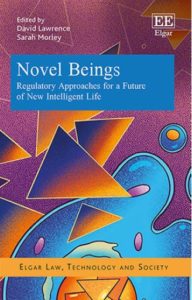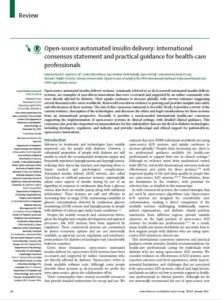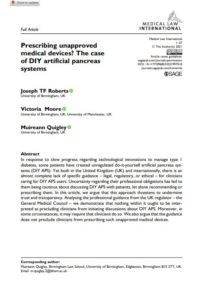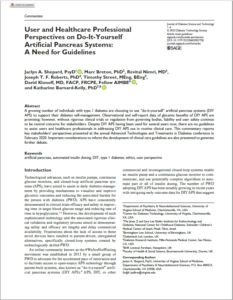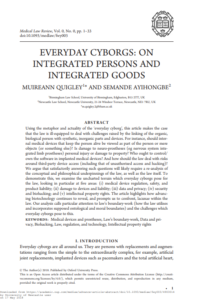2023
‘A European regulatory pathway for Tidepool loop following clearance in the United States?’
Diabetic Medicine
Author: Laura Downey, Shane O’Donnell, Tom Melvin, and Muireann Quigley
Read the full article here or by clicking on the image (right)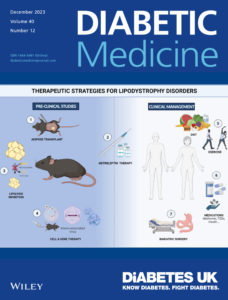
The recent clearance by the United States Food and Drug Administration of Tidepool Loop sets an important precedent within the medical device landscape. For the first time, an automated insulin delivery mobile application—based on an algorithm initially designed and developed by users —has been recognised as safe and effective by a regulatory body. The aim of this paper is twofold: firstly, we map out the regulatory pathways and processes that were navigated by Tidepool, the non-profit behind Tidepool Loop, in order to make this landmark moment possible. Secondly, we set out potential approvals processes in the European Union and United Kingdom with a view to examining the challenges to obtaining regulatory clearance for Tidepool Loop in these jurisdictions. In so doing, we highlight the significant differences, not only between the United States and European systems but also between the European Union and Great Britain systems. We conclude by arguing that the complexity encountered when seeking to introduce an innovative solution in different regulatory systems has the potential to act as a disincentive to open source developers from seeking regulatory approvals for such technologies in the future.
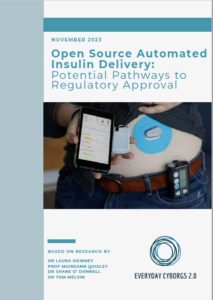 To accompany this article, we have also published a short briefing note summarising the main points. This is available here or by clicking on the image (right).
To accompany this article, we have also published a short briefing note summarising the main points. This is available here or by clicking on the image (right).
‘Regulatory Futures and Medical Devices: Where Next for Europe and the United Kingdom?’
Law, Technology, and Humans
Editors: Muireann Quigley, Laura Downey, and Joseph Roberts
Read the full symposium here or by clicking on the image (right)
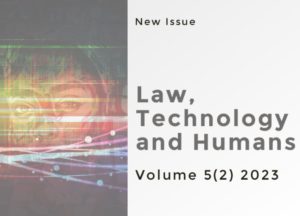 The symposium in this issue of Law, Technology and Humans brings together a range of scholars looking at the broad question of where next for medical devices regulation in the European Union (EU) and the United Kingdom (UK). Initially arising out of a workshop held in September 2022, our motivation for the symposium is rooted in the challenges raised by what has been a significant period of change in both the EU and the UK when it comes to medical devices regulation.
The symposium in this issue of Law, Technology and Humans brings together a range of scholars looking at the broad question of where next for medical devices regulation in the European Union (EU) and the United Kingdom (UK). Initially arising out of a workshop held in September 2022, our motivation for the symposium is rooted in the challenges raised by what has been a significant period of change in both the EU and the UK when it comes to medical devices regulation.
Each of the seven articles in this symposium tackles some of the gaps and challenges currently being faced regarding the regulation of medical devices in the EU and the UK. These contributions range from questions of what to do when medical devices go wrong (Macleod) and the limitations of current law and regulation (Quigley and colleagues) to how best to address cybersecurity concerns relating to medical devices (Biasin and colleagues; Ludvigsen). Three of the contributions also deal with pressing questions relating to regulating emerging (medical device) technologies including fertility tracking apps (McMillan), artificial intelligence (Li and colleagues), and bio-artificial pancreases (Cronin and Thom).
‘Taking Embodiment Seriously in Public Policy and Practice: Adopting a Procedural Approach to Health and Welfare’
Monash Bioethics Review
Author: Joseph T F Roberts
Read the full version here or by clicking on the image (right)
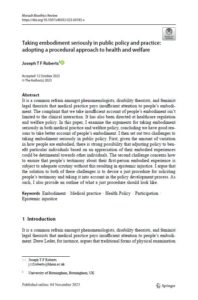 It is a common refrain amongst phenomenologists, disability theorists, and feminist legal theorists that medical practice pays insufficient attention to people’s embodiment. The complaint that we take insufficient account of people’s embodiment isn’t limited to the clinical interaction. It has also been directed at healthcare regulation and welfare policy. In this paper, I examine the arguments for taking embodiment seriously in both medical practice and welfare policy, concluding we have good reasons to take better account of people’s embodiment. I then set out two challenges to taking embodiment seriously in public policy. First, given the amount of variation in how people are embodied, there is strong possibility that adjusting policy to benefit particular individuals based on an appreciation of their embodied experiences could be detrimental towards other individuals. The second challenge concerns how to ensure that people’s testimony about their first-person embodied experience is subject to adequate scrutiny without this resulting in epistemic injustice. I argue that the solution to both of these challenges is to devise a just procedure for soliciting people’s testimony and taking it into account in the policy development process. As such, I also provide an outline of what a just procedure should look like.
It is a common refrain amongst phenomenologists, disability theorists, and feminist legal theorists that medical practice pays insufficient attention to people’s embodiment. The complaint that we take insufficient account of people’s embodiment isn’t limited to the clinical interaction. It has also been directed at healthcare regulation and welfare policy. In this paper, I examine the arguments for taking embodiment seriously in both medical practice and welfare policy, concluding we have good reasons to take better account of people’s embodiment. I then set out two challenges to taking embodiment seriously in public policy. First, given the amount of variation in how people are embodied, there is strong possibility that adjusting policy to benefit particular individuals based on an appreciation of their embodied experiences could be detrimental towards other individuals. The second challenge concerns how to ensure that people’s testimony about their first-person embodied experience is subject to adequate scrutiny without this resulting in epistemic injustice. I argue that the solution to both of these challenges is to devise a just procedure for soliciting people’s testimony and taking it into account in the policy development process. As such, I also provide an outline of what a just procedure should look like.
‘Taking Embodiment Seriously in Ethics and Political Philosophy’
Journal of Value Inquiry
Author: Joseph T F Roberts
Read the full version here or by clicking on the image (right)
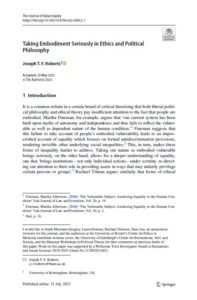 It is a common refrain in a certain brand of critical theorising that both liberal political philosophy and ethical theory pay insufficient attention to the fact that people are embodied. Care ethicists, for example, argue that liberalism’s abstract conception of the self prioritises independence and autonomy, obscuring our inevitable and universal vulnerability as embodied beings. Similar charges are often levelled against mainstream deontological and consequentialist ethical theories. Due to their commitment to the use of abstract principles in moral reasoning, these views are purportedly forced to ignore the importance of contextual facts (including facts about people’s embodiment) in determining what is right and/or good.
It is a common refrain in a certain brand of critical theorising that both liberal political philosophy and ethical theory pay insufficient attention to the fact that people are embodied. Care ethicists, for example, argue that liberalism’s abstract conception of the self prioritises independence and autonomy, obscuring our inevitable and universal vulnerability as embodied beings. Similar charges are often levelled against mainstream deontological and consequentialist ethical theories. Due to their commitment to the use of abstract principles in moral reasoning, these views are purportedly forced to ignore the importance of contextual facts (including facts about people’s embodiment) in determining what is right and/or good.
In this paper I argue two things. First, that far from presupposing a disembodied view of the self, ethical and political theories that make use of the notions of harm, autonomy, and fairness cannot (and ought not to) justifiably be cashed out without taking account of people’s embodied nature. Second, the paper argues that taking people’s embodiment seriously is compatible with the use of principles in ethics and political philosophy. Although poorly formulated principles may lead to erroneous decision, as recent work in the ethics of care shows, there is nothing barring us from incorporating contextual facts (including facts about how people are embodied) into the formulation and application of our principles.
2022
‘Being Novel? Regulating Emerging Technologies Under Conditions of Uncertainty’
In Lawrence, David and Morley, Sarah (Eds) Novel Beings: Regulatory Approaches for a Future of New Intelligent Life (Edward Elgar Publishing 2022).
Authors: Joseph T F Roberts and Muireann Quigley
Read the full version here or by clicking on the image (right)
If we accept that at some point novel beings will be brought into existence, then we need to consider how the law should take account of (the emergence of) such beings. This is a sticky problem, because any attempt to engage in preparatory regulation with respect to novel beings is mired in uncertainty. Put simply, we do not know what type of beings they will be, either in terms of their physical nature/embodiment or mental/cognitive characteristics. As a consequence, we lack the relevant context-dependent information needed to propose a detailed regulatory regime. In light of this epistemic uncertainty, in this chapter we do not propose a detailed account of law and regulation for novel beings. Instead, we outline a range of normative principles which could help guide the regulation of precursor technologies without undermining our ability to appropriately regulate emerging novel beings in the future.
‘Open-Source automated insulin delivery: international consensus statement and practical guidance for health-care professionals’
Lancet Diabetes Endocrinology (2022) 10 (1): 58-74
Authors: Katarina Braune, Rayhan A Lal, Lenka Petruželková, Gary Scheiner, Per Winterdijk, Signe Schmidt, Linda Raimond, Korey K Hood, Michael C Riddell, Timothy C Skinner, Klemens Raile, Sufyan Hussain on behalf of the OPEN International Healthcare Professional Network OPEN Legal Advisory Group.
A full list of members of the advisory group, including Muireann Quigley, is available in the appendix of the article.
Read the full version here or by clicking on the image (right)
Open-source automated insulin delivery systems, commonly referred to as do-it-yourself automated insulin delivery systems, are examples of user-driven innovations that were co-created and supported by an online community who were directly affected by diabetes. Their uptake continues to increase globally, with current estimates suggesting several thousand active users worldwide. Real-world user-driven evidence is growing and provides insights into safety and effectiveness of these systems. The aim of this consensus statement is two-fold. Firstly, it provides a review of the current evidence, description of the technologies, and discusses the ethics and legal considerations for these systems from an international perspective. Secondly, it provides a much-needed international health-care consensus supporting the implementation of open-source systems in clinical settings, with detailed clinical guidance. This consensus also provides important recommendations for key stakeholders that are involved in diabetes technologies, including developers, regulators, and industry, and provides medico-legal and ethical support for patient-driven, open-source innovations.
‘Integrating the Biological and the Technological: Time to Move Beyond Law’s Binaries?’
In Dove, E.S. & Nic Shuibhne, N. (Eds) Law and Legacy in Medical Jurisprudence: Essays in Honour of Graeme Laurie (Cambridge University Press 2022)
Authors: Muireann Quigley and Laura Downey
Read the full version here or by clicking on the image (right)
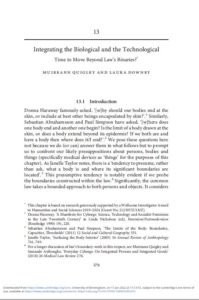 The common law takes a bounded approach to persons and objects: something is either a person (subject) or a thing (object), but not both. This conceptualisation of persons as bounded selves and objects as separate from persons represents an encumbrance that goes to the very heart of law. The person–thing binary is so fundamental that it both structures the law conceptually and dictates its practical applications. This chapter explores the consequences of this legacy in relation to ‘everyday cyborgs’ – that is, persons with attached and implanted medical devices. Drawing on Graeme Laurie’s work, it argues that recognising the inherent liminality of everyday cyborgs (and everyday cyborg technologies) allows us to look beyond law’s binaries more fully to account for the ‘spaces in-between’. The chapter finds that Laurie’s liminal analysis of law and his framework for processual regulation give us much needed analytical tools to begin to look beyond boundaries, beyond binaries and beyond bodies.
The common law takes a bounded approach to persons and objects: something is either a person (subject) or a thing (object), but not both. This conceptualisation of persons as bounded selves and objects as separate from persons represents an encumbrance that goes to the very heart of law. The person–thing binary is so fundamental that it both structures the law conceptually and dictates its practical applications. This chapter explores the consequences of this legacy in relation to ‘everyday cyborgs’ – that is, persons with attached and implanted medical devices. Drawing on Graeme Laurie’s work, it argues that recognising the inherent liminality of everyday cyborgs (and everyday cyborg technologies) allows us to look beyond law’s binaries more fully to account for the ‘spaces in-between’. The chapter finds that Laurie’s liminal analysis of law and his framework for processual regulation give us much needed analytical tools to begin to look beyond boundaries, beyond binaries and beyond bodies.
2021
‘#WeAreNotWaiting DIY artificial pancreas systems and challenges for the law’
Diabetic Medicine, DOI: 10.1111/dme.14715
Authors: Rachael Dickson, Jessica Bell, Amber Dar, Laura Downey, Victoria Moore & Muireann Quigley
Read the full version here or by clicking on the image (right)
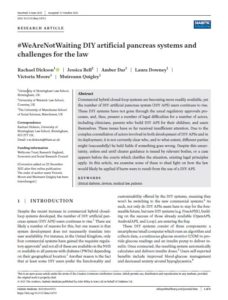 Commercial hybrid closed- loop systems are becoming more readily available, yet the number of DIY artificial pancreas system (DIY APS) users continues to rise. These DIY systems have not gone through the usual regulatory approvals pro-cesses, and, thus, present a number of legal difficulties for a number of actors, including clinicians, parents who build DIY APS for their children, and users themselves. These issues have so far received insufficient attention. Due to the complex constellation of actors involved in both development of DIY APSs and in its deployment, it is not currently clear who, and to what extent, different parties might (successfully) be held liable if something goes wrong. Despite this uncer-tainty, unless and until clearer guidance is issued by relevant bodies, or a case appears before the courts which clarifies the situation, existing legal principles apply. In this article, we examine some of these to shed light on how the law would likely be applied if harm were to result from the use of a DIY APS.
Commercial hybrid closed- loop systems are becoming more readily available, yet the number of DIY artificial pancreas system (DIY APS) users continues to rise. These DIY systems have not gone through the usual regulatory approvals pro-cesses, and, thus, present a number of legal difficulties for a number of actors, including clinicians, parents who build DIY APS for their children, and users themselves. These issues have so far received insufficient attention. Due to the complex constellation of actors involved in both development of DIY APSs and in its deployment, it is not currently clear who, and to what extent, different parties might (successfully) be held liable if something goes wrong. Despite this uncer-tainty, unless and until clearer guidance is issued by relevant bodies, or a case appears before the courts which clarifies the situation, existing legal principles apply. In this article, we examine some of these to shed light on how the law would likely be applied if harm were to result from the use of a DIY APS.
‘International Consensus on the Ethics of Open-Source Automated Insulin delivery’ [Conference Abstract]
‘Prescribing Unapproved Medical Devices? The case of DIY Artificial Pancreas Systems’
Medical Law International (2021) 21(1): 42-68
Authors: Joseph T.F. Roberts, Victoria Moore, Muireann Quigley
Read the full version here or by clicking on the image (right)
In response to slow progress regarding technological innovations to manage type one diabetes, some patients have created unregulated Do-It- Yourself Artificial Pancreas Systems (DIY APS). Yet both in the United Kingdom (UK) and internationally, there is an almost complete lack of specific guidance – legal, regulatory, or ethical – for clinicians caring for DIY APS users. Uncertainty regarding their professional obligations has led to them being cautious about discussing DIY APS with patients, let alone recommending or prescribing them. In this paper we argue that this approach threatens to undermine trust and transparency. Analysing the professional guidance from the UK regulator – the General Medical Council – we demonstrate that nothing within it ought to be interpreted as precluding clinicians from initiating discussions about DIY APS. Moreover, in some circumstances it may require that clinicians do so. We also argue that the guidance does not preclude clinicians from prescribing such
unapproved medical devices.
Publication of this paper was covered by a number of online publications: Pharmacy Times, Medscape, MedicalXpress, childrenwithdiabetes.com, Patient Safety Learning’s online platform The Hub, and the American Association for the Advancement of Science’s EurekAlert!
2020
‘User and Healthcare Professional Perspectives on Do-It-Yourself Artificial Pancreas Systems: A Need for Guidelines’
Journal of Diabetes Science and Technology
Authors: Jacyln A Shepard, Marc Breton, Revital Nimri, Joseph T F Roberts, Timothy Street, David Klonoff, and Katherine Barnard Kelly
Read the full version here or by clicking on the image (right)
A growing number of individuals with type 1 diabetes are choosing to use “do-it-yourself” artificial pancreas systems (DIY APS) to support their diabetes self-management. Observational and self-report data of glycemic benefits of DIY APS are promising; however, without rigorous clinical trials or regulation from governing bodies, liability and user safety continue to be central concerns for stakeholders. Despite DIY APS having been used for several years now, there are no guidelines to assist users and healthcare professionals in addressing DIY APS use in routine clinical care. This commentary reports key stakeholders’ perspectives presented at the annual Advanced Technologies and Treatments in Diabetes conference in February 2020. Important considerations to inform the development of clinical care guidelines are also presented to generate further debate.
2018
‘Everyday Cyborgs: On Integrated Persons and Integrated Goods’
Medical Law Review
Authors: Muireann Quigley and Semande Ayihongbe
Read the full version here or by clicking on the image (right)
Using the metaphor and actuality of the ‘everyday cyborg’, this article makes the case that the law is ill-equipped to deal with challenges raised by the linking of the organic, biological person with synthetic, inorganic parts and devices. For instance, should internal medical devices that keep the person alive be viewed as part of the person or mere objects (or something else)? Is damage to neuro-prostheses (eg nervous system integrated limb prostheses) personal injury or damage to property? Who ought to control/own the software in implanted medical devices? And how should the law deal with risks around third-party device access (including that of unauthorised access and hacking)? We argue that satisfactorily answering such questions will likely require a re-analysis of the conceptual and philosophical underpinnings of the law, as well as the law itself. To demonstrate this, we examine the uncharted terrain which everyday cyborgs pose for the law, looking in particular at five areas: (i) medical device regulation, safety, and product liability; (ii) damage to devices and liability; (iii) data and privacy; (iv) security and biohacking; and (v) intellectual property rights. The article highlights how advancing biotechnology continues to reveal, and prompts us to confront, lacunae within the law. Our analysis calls particular attention to law’s boundary-work (how the law utilises and incorporates supposed ontological and moral boundaries) and the challenges which everyday cyborgs pose to this.
Work on this paper was supported by a Wellcome Trust Seed Award in Humanities and Social Science 2016 (Grant No: 201675/Z/16/Z).

